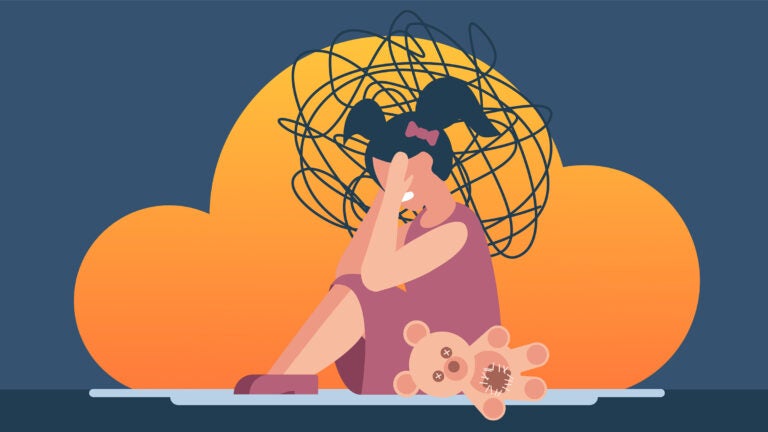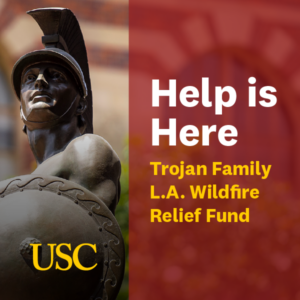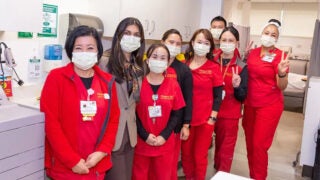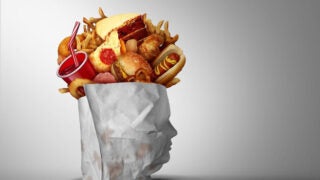
Children’s responses to traumatic events like the recent wildfires can vary widely. (Illustration/iStock)
Parenting through disaster: How California’s wildfires are affecting children and families
As families cope with the loss of homes, schools and communities, USC experts offer guidance to help parents and children make sense of tragedy, protect their health and find hope.
As Angelenos — many still displaced or facing the ongoing threat of new blazes — return to neighborhoods scarred by wildfires, parents shoulder the task of guiding their children through the emotional, physical and social challenges that come with recovering from catastrophe.
Recent fires in the Castaic area in northern Los Angeles County and in parts of San Diego County have only added to the devastation. The destruction of schools and other vital community spaces has left families without the support systems they rely on. Meanwhile, smoke and ash from the fires continue to spread, compounding concerns about children’s physical health and safety.
“When families with children experience disaster-induced community loss and displacement, they are not only in need of a place to sleep at night, but also a place that becomes the center of the full ecosystem of informal support and formal institutions on which parents and children are dependent,” said Emily Smith-Greenaway, a professor of sociology and spatial sciences at the USC Dornsife College of Letters, Arts and Sciences.
“Anyone who lives in a community is rooted in it, but kids have a way of creating a deeper, more complex root system, making the uprooting of it all and the need to replant one’s family elsewhere an especially daunting task.”
Understanding responses to trauma
There are hallmark signs of post-traumatic stress in both children and adults, USC experts say.
“After a scary event, both kids and adults may be especially sensitive to danger cues or reminders of the threatening event. They might experience flashbacks, bad dreams, a hair-trigger startle response or a desire to avoid cues — like certain places, people or even sensory experiences, like the smell of smoke — that remind them of the trauma,” said Darby Saxbe, a professor of psychology and principal investigator of the NeuroEndocrinology of Social Ties (NEST) Lab at USC Dornsife.

Employees affected by the wildfire may now apply for a grant of funds. Please visit the Wildfire Relief Fund Grants information page for details about eligibility, instructions on how to apply for a grant and a list of frequently asked questions.
Please continue to check the community resources for emergency response support page for updates and more information.
“It’s also very normal for trauma survivors to feel irritable, sad or burned out. Importantly, even vicarious trauma — like seeing images of the fire on the news — can affect our sense of safety and well-being,” she said.
Children’s responses to traumatic events like the recent wildfires can vary widely. While some may show immediate signs of distress, others might not display any noticeable signs of trauma until much later, according to USC experts.
“For some, there may have been an immediate fear during the event. This is a typical response, particularly as children watch how much distress their parents might have been experiencing during the events,” said Julie Cederbaum, an associate professor at the USC Suzanne Dworak-Peck School of Social Work. “For others, the impact of the fires, even if one’s home was not directly impacted, may be more long-lasting.”
Children show their worries and fears differently based on their age and development, she added. Toddlers, who often use play to process emotions, might act out fire-related scenarios. Younger children may also regress, returning to behaviors they showed at earlier ages, Cederbaum explained.
“Allowing space for children to process their thoughts and feelings and being patient with children displaying regressive behaviors is important. For school-age children, providing space for them to talk about what they have heard and to explain things to them using age-appropriate language helps them know it is OK to talk about their thoughts and feelings with you,” she said.
The role of schools in recovery
As parents turn their attention to rebuilding their homes and communities, schools become a critical partner in ensuring children’s well-being.
“Schools play such a vital role in providing a safe space and reestablishing stability,” said Vivien Villaverde, an associate professor at the USC Suzanne Dworak-Peck School of Social Work, who specializes in helping school communities recover from traumatic events. She is currently providing psychological first aid training to school staff as they prepare to support students affected by the recent fires.
“Parents are going to rely heavily on schools in terms of creating a safe space, a routine and predictability, so they don’t have to worry about the kids as they attend to the priorities of rebuilding,” said Villaverde, who also co-founded the Center for Safe & Resilient Schools and Workplaces.
Addressing physical health: Respiratory health in children is top of mind for doctors
In addition to the emotional toll, the physical health risks posed by wildfire smoke are a significant concern, especially for children with asthma or other respiratory conditions. Veronica Vasquez-Montez, associate chief medical officer and medical director of the emergency department at USC Arcadia Hospital, said she has seen an uptick in cases of asthma-related issues among children in her hospital’s emergency department.
“Exposure to wildfire smoke and other toxins in the air can be detrimental to children with asthma and other underlying respiratory conditions,” she said. “Environmental irritants such as these can trigger an asthma exacerbation, including wheezing, coughing, shortness of breath and chest tightness.”
Parents and guardians with children in areas affected by wildfire smoke should be especially vigilant to avoid strenuous exercise outdoors. If the air quality is especially poor, using an N95 or KN95 mask is recommended, advises Carl Chudnofsky, an emergency medicine physician with Keck Medicine of USC and chair of the Department of Emergency Medicine with the Keck School of Medicine of USC.
“Children are particularly vulnerable because they breathe more air relative to their body size and are often outdoors,” said Michelle Chu, an assistant professor at the USC Alfred E. Mann School of Pharmacy and Pharmaceutical Sciences.
Chu recommends creating a clean air room by using air conditioning with a high-efficiency filter and sealing windows and doors to prevent outdoor air from entering.
“If asthma symptoms worsen, refer to the personalized asthma action plan. Ensure sufficient medication is on hand and review proper inhaler techniques with your child,” she said. “Consult a health care provider during routine checkups to adjust the plan as needed for wildfire season.”
Access to resources ‘color every dimension’ of wildfire recovery, expert says
Though fires burn indiscriminately, the ability to recover from a disaster isn’t evenly distributed, Smith-Greenaway said. Access to resources play a critical role in determining who can effectively navigate the challenges and rebuild their lives.
“There is often a sense that Mother Nature is the great equalizer: She pays no mind to what we humans engineer and manufacture, including the inequalities on which we build our societies,” said Smith-Greenaway, whose research examines how social factors, including inequalities, shape the experiences of individuals and families.
“Yet in reality access to resources color every dimension of navigating a natural disaster — the ability to prepare, to protect and to pick up the pieces in its aftermath is aided by resources,” she said.
Well-resourced families, who are embedded in similarly resourced family and social support networks, can more effectively find the stability and resources needed to grieve their losses in a secure and supportive environment, Smith-Greenaway said.
“Those who lack such financial security will likely smother their grief out of a necessity to focus on their survival, even if at the expense of their well-being,” she said.



